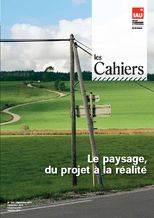Landscape, from plans to reality
It is not growth that is measured any more but development. We measure differently by adding new factors to wealth such as well-being, health and accomplishment. Landscape shows the link in between man and nature. The landscape question is one that covers global problems. The idea is to broaden our measurements, even if it means using complex equations.
Understanding
Understanding landscape as an object has considerably progressed over the last 20 or 30 years. The matter is therefore not to go back to this knowledge, but to pinpoint the new questions that it raises and the stakes that it makes appear. What are the new looks, the new landscapes and the new actions that are undertaken? In a plural society, how can looks that are sometimes contradictory, and each of them legitimate, coexist? What landscape and what society do we wish? What relations between places, between people, between places and people? Landscape is a social reality; as such it is a part of one of the three pillars of sustainable development: the social. Landscape, as other facts of society (ways of living, roots, commitments, sexuality, family, politics, religion…), being more and more a choice rather than something given, it is important that this choice be informed. The goal remains sustainability –neither a static society nor static landscapes, but taking their evolution into account.
Identity of territories and units of landscape
Landscape following in the footsteps of Human Rights
Taking action
In order to make landscape studies more effective, with regards to their objectives, it is useful to know the conditions of the implementation: how are the knowledge tools mobilised? What actual impact each tool has had? How is the passage from thought to action, from design to reality? Some projects make this link visible. Large enough to have an effect on the landscape, beyond their setting, they may be achieved by a sole owner, but also be managed by multiple stakeholders, who must find the ways of a common management. Those projects must be considered as places of experiment, bearing lessons for other territories, and not as exceptions, even when they benefit from special attention and means (regional natural parks, “strategic sites”, greenbelt, and places of high heritage value, such as the Versailles Plain…). How can the limits of the project be overcome? Among the ways of achieving this are: revealing the unique characters that are gathered under the name of genius loci: taking the “long time” and the evolving character of a place into account; conducting a “landscape approach” that integrates and unites scattered projects, whether former of newer.
Landscape research. Why is it important?
The Versailles Plain: from plans to reality
Using landscape to imagine a "post-carbon" land
Landscape: an indicator of well-being?
Anticipating
“Landscape” means an area, “as perceived by people”, states the European Landscape Convention, adding that its “character is the result of the action and interaction of natural and –or human factors”. Landscape is therefore not a mere image: it is a place of living, and beyond the highlighting of good examples, it is important to ask “a landscape, for whom?”; it is shaped by people, and beyond what is seen, it is important to ask” a landscape, by whom?” This section identifies some examples of new practices that give courses of action for the future, answering either “for whom?” with the attention to inhabitants and users, or “by whom?” with projects of rural and urban planning stakeholders, and with awareness raising and training of tomorrow’s actors. A landscape cannot be conserved without conserving the activities that produced it and the people who practised those activities. A landscape cannot evolve in a satisfactory way if those activities are in jeopardy. Beyond professionals and decision-makers, the entire society is concerned.
This study is linked to the following theme :
Environment
